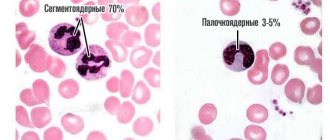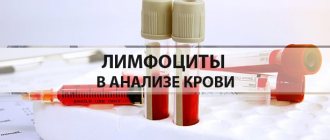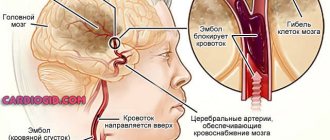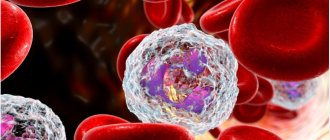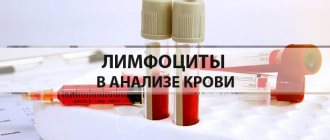Monitoring basic blood parameters is very important. If their level is normal, this means that the person is healthy. Particular attention is paid to children from the first days of life. A blood test is prescribed both to assess the general condition and in case of suspected disease.
During a general blood test, the values of all important parameters are determined, including the level of neutrophils, which are a type of granular leukocytes (granulocytes). Their main purpose is phagocytosis, or the process of capturing and absorbing solid particles. Neutrophils and lymphocytes perform an important function for the body - protective. A normal level of these cells provides reliable immunity. If neutrophils are low or high, the child most likely has a disease.
The number of neutrophils must be determined during a general blood test in children
Normal in children
As you know, the norm for children is different from the norm for adults. In addition, the age of the child matters. The number of neutrophils is determined during the calculation of the leukocyte formula included in the clinical blood test. The total number of neutrophilic granulocytes is determined, as well as their relative value, which is expressed as a percentage. Unlike adults, children have immature, that is, rod forms, in their blood, and this is the norm. In general, the number of mature (segmented) cells ranges from 16 to 70%, young - from 3 to 12% in newborns and from 1 to 5% in children, starting from the second week of life.
The neutrophil content should be as follows:
- in a newborn - the total amount per liter of blood is 1.5-8X10⁹, with segmented ones making up 45-80%, band ones - 3-17%;
- in children under one year old - the total number is 1.8-8.5X10⁹, mature - 15-45%, immature - 0.5-4%;
- from one to 13 years - total amount - 2-6X10⁹, mature - 35-62%, immature - 0.7-5%.
In children 13 years of age and older, the number of neutrophils approaches the adult norm.
How to prepare your child for a blood test for neutrophils
An analysis for segmented neutrophils is done from capillary blood, which is taken from a finger in children, and from a toe or heel in newborns.
You need to bring your child in the morning on an empty stomach, without even giving him tea. Breastfeeding is allowed on a schedule. The baby should be reassured. After the analysis, do not rub your finger or treat it with an apple or banana.
Since your cell levels can be affected by the medications you are taking, it is best to ask your doctor in advance whether you need to stop taking them and for how long.
If the cause of a change in the level of segmented neutrophils is detected in a child, treatment is directed to the underlying disease. In any case, parents are required to comply with the basic requirements for the daily routine and nutrition of their children.
Causes of elevated neutrophils
If the level of neutrophils in children exceeds the norm slightly, most likely there is no cause for concern. This condition can occur after physical activity.
If there is a significant and persistent increase, then the child should be examined. The reasons may be different, including acute processes, malignant tumors, tissue necrosis. You can read about the reasons for increased neutrophil levels in adults here.
Neutrophilia is usually explained by the following diseases:
- hemolytic anemia;
- leukemia;
- abscesses;
- appendicitis;
- diabetes;
- acute inflammatory diseases such as tonsillitis, pneumonia, otitis media, sepsis, peritonitis, bronchitis, etc.;
- trophic ulcers;
- severe burns (third and fourth).
The level of these cells directly depends on the intensity of the pathological process. If neutrophils are significantly elevated, prompt diagnosis and timely treatment are needed.
An increase in neutrophils in the blood of a child is observed in many diseases. To find out the cause, a thorough examination is required
The total number of neutrophils in a child may be normal, but the segmented forms are increased, that is, there is a shift of the leukogram to the right. This may indicate the following processes in the body:
- infectious diseases, sometimes occurring without clinical manifestations;
- acute inflammation;
- tumors (benign and malignant).
The importance of neutrophils in the diagnosis of diseases
Cell characteristics
As mentioned above, neutrophils are a type of granulocytic leukocyte. They belong to this group of white blood cells, since they have granules in their composition, or rather in the cytoplasm. They contain various types of compounds: proteins, enzymes, and so on. They provide functions to neutrophilic leukocytes.
Role in the body
Neutrophils make up the majority of all leukocytes. Everyone knows that white blood cells protect our body. How does this happen?
When a foreign agent enters the body, substances are produced that attract neutrophils to the site of penetration. There, neutrophil leukocytes phagocytose, that is, absorb a foreign agent. The granules contained inside the neutrophil help digest the foreign compound.
The difference between neutrophils and other cells that can “eat” other molecules is their viability after phagocytosis. Neutrophils participate in phagocytosis once in their lives (after which they die), while other macrophages can do this many times.
Thus, this type of leukocyte is one of the first factors in the body’s defense against foreign agents.
Type of neutrophils
There are several types of leukocytes, differing in maturity. Initially, the maturation of this type of leukocyte begins in the same way as others - from a precursor cell. Then, during differentiation, a myeloblast is formed from it, then a promyelocyte. Already at this stage, granules begin to appear in the cells. Next, a myelocyte is formed, then a metamyelocyte. It is also called a young neutrophil.
Under some conditions, young neutrophilic leukocytes can be detected in the peripheral blood.
A band form is formed from the metamyelocyte. It is named after the shape of the kernel at this stage of maturation. The final, mature cell is the segmented neutrophil. It differs from its predecessor in the structure of the nucleus: segments are formed from the so-called rod, connected by constrictions.
Decreased neutrophils
Neutropenia in a child indicates a decrease in immune defense. This condition is associated with the rapid destruction of neutrophils, with their insufficient production or improper distribution in the body.
The development of neutropenia is indicated if the child’s level of these cells is below normal and ranges from 1.6X10⁹ per liter and below. The main causes of development are previous diseases or dysfunction of the bone marrow. In the latter case, the death of neutrophils occurs, and the process of their recovery is difficult.
There are several other reasons for low neutrophil granulocyte counts. At the same time, they can be reduced both quantitatively and in percentage terms. There may be few mature and immature forms in the blood. This happens in the following diseases:
- fungal infections;
- diseases of viral etiology: influenza, hepatitis, measles, rubella, ARVI, and so on;
- poisoning due to exposure to chemicals;
- anaphylactic shock that occurred in the recent past;
- irradiation;
- thyrotoxicosis;
- acute leukemia;
- anemia of various origins (iron deficiency, megaloblastic, hypoplastic and aplastic).
Reduced neutrophils are observed after taking certain medications, which include glucocorticosteroids, painkillers and anticonvulsants.
If a child's neutrophils are low, their level remains unchanged during the first year of life and his health is normal, there is usually no need to worry. The neutrophil count will return to normal on its own after some time.
A decrease in the level of neutrophils in children is typical for common viral infections such as acute respiratory viral infections, influenza and others.
Low neutrophils are characteristic of congenital severe neutropenia. This disease is rare, it is genetically determined and leads to immunodeficiency.
Against the background of high lymphocytes
In young children, the leukocyte formula is normally different. Up to 4-5 years (at this age there is a physiological crossover, when the value becomes the same as in an adult), the relative content of lymphocytes is 47-72%. Then they gradually decrease, changing places with leukocytes.
If, after passing this milestone, the child has a large number of lymphocytes and the level of segmented neutrophils is reduced, then a viral or severe specific bacterial infection should be suspected. If there are no symptoms, then the disease may simply proceed in a latent form. But it must be taken into account that after a serious illness, residual effects in a blood test can persist for up to a month.
A reduced number of segments against the background of lymphocytosis accompanies such serious diseases as hepatitis, measles, rubella, whooping cough, tuberculosis and even HIV infection. Given the unhealthy tendency of parents not to vaccinate their children, the problem is becoming increasingly urgent.
The combination of low segmented neutrophils and lymphocytosis occurs with helminthiases, and an important criterion in diagnosis is the number of eosinophils.
If the results of laboratory tests are not normalized, then this is a serious reason to undergo additional examination for a hidden pathological process.
Benign neutropenia
In infancy, children may experience a chronic disease such as benign neutropenia of childhood, abbreviated as CDNV. In this condition, a significant decrease in neutrophils is detected in the blood. The disease manifests itself in the first months of life and rarely lasts longer than 2 years. As a rule, there are no symptoms, the child grows and develops normally, and is registered with a pediatrician, hematologist, and immunologist. CDNV does not require treatment and goes away on its own.
Decoding the leukocyte formula
When deciphering the leukogram, its shift towards increasing or decreasing segmented or band cells is taken into account. A shift to the left indicates an increase in the level of young forms, a shift to the right indicates an increase in mature ones.
The entry of band forms into the blood is typical for severe inflammation and malignant tumors. With a shift to the right, one can judge the presence of the following pathologies:
- anemia;
- liver and kidney diseases;
- radiation sickness.
When deciphering a blood test, all indicators are taken into account and considered in their entirety. If lymphocytes are increased, neutrophils are decreased, most likely, the disease, for example, ARVI or influenza, is already receding. If neutrophils are low and lymphocytes are low, or the latter are normal, this indicates a chronic viral infection, and the child often gets sick and immunity is reduced.
How is the level of neutrophils in the blood calculated?
To perform a neutrophil count, blood is required. Any one is suitable for this: taken from a vein or capillary. In newborns, blood may be taken from the heel. The study of the type of white blood cells is called leukocyte count. It is performed during a general clinical blood test (CBC).
This study is most often carried out using a microscope and a special cell counter. The specialist examines the blood smear and counts all the types of cells that he saw. Counts one hundred cells in a smear. Next, writes the result on the answer form.
Staining of smears is used to differentiate different cells from each other. The Romanowsky-Giemsa method is most often used for staining blood smears.
For heavy laboratory workloads, it is possible to count cells using an automatic hematology analyzer. But not all laboratories can be equipped with such devices. Which brings us back to the manual method and the value of experts in the field.
